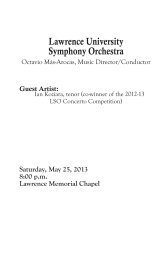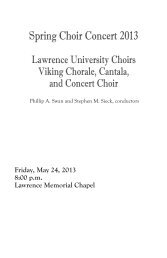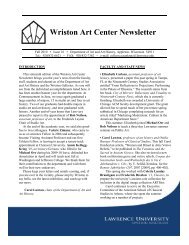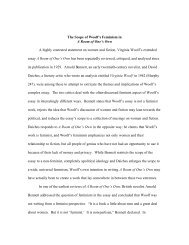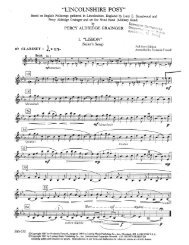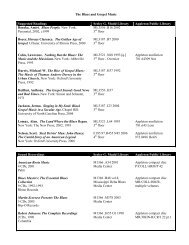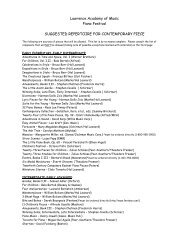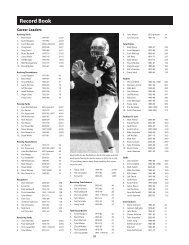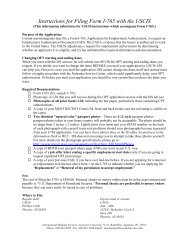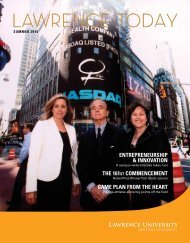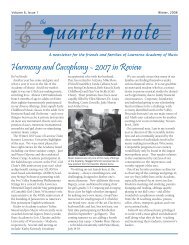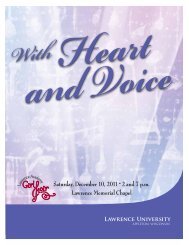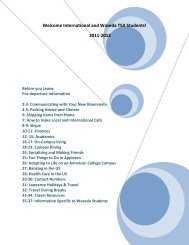Hemispheric asymmetries and joke comprehension - Lawrence ...
Hemispheric asymmetries and joke comprehension - Lawrence ...
Hemispheric asymmetries and joke comprehension - Lawrence ...
Create successful ePaper yourself
Turn your PDF publications into a flip-book with our unique Google optimized e-Paper software.
Abstract<br />
Neuropsychologia 43 (2005) 128–141<br />
<strong>Hemispheric</strong> <strong>asymmetries</strong> <strong>and</strong> <strong>joke</strong> <strong>comprehension</strong><br />
Seana Coulson a,∗ , Robert F. Williams a,b<br />
a Cognitive Science Department, University of California, San Diego, 9500 Gilman Drive, La Jolla, CA 92093-0515, USA<br />
b <strong>Lawrence</strong> University, Appleton, WI 54912, USA<br />
Received 5 June 2003; received in revised form 20 January 2004; accepted 21 March 2004<br />
Joke <strong>comprehension</strong> deficits in patients with right hemisphere (RH) damage raise the question of the role of the intact RH in underst<strong>and</strong>ing<br />
<strong>joke</strong>s. One suggestion is that semantic, or meaning, activations are different in the RH <strong>and</strong> LH, <strong>and</strong> RH meanings are particularly important<br />
for <strong>joke</strong> <strong>comprehension</strong>. To assess whether hypothesized differences in semantic activation in the two hemispheres were relevant to <strong>joke</strong><br />
<strong>comprehension</strong>, we recorded event-related brain potentials (ERPs) as healthy adults read laterally presented “punch words” to one-line<br />
<strong>joke</strong>s <strong>and</strong> non<strong>joke</strong> controls. Jokes presented to the RVF/LH elicited larger amplitude N400 than the non<strong>joke</strong> endings; when presented to<br />
the LVF/RH, the <strong>joke</strong> <strong>and</strong> non<strong>joke</strong> endings elicited N400s of equal amplitude. This finding suggests that semantic activations in the two<br />
hemispheres do differ, with RH semantic activation facilitating <strong>joke</strong> <strong>comprehension</strong>.<br />
© 2004 Elsevier Ltd. All rights reserved.<br />
Keywords: <strong>Hemispheric</strong> <strong>asymmetries</strong>; Joke <strong>comprehension</strong>; Semantic activation<br />
1. <strong>Hemispheric</strong> <strong>asymmetries</strong> <strong>and</strong> <strong>joke</strong> <strong>comprehension</strong><br />
The study of brain damaged patients suggests the two<br />
hemispheres differ markedly in their importance for language<br />
processing. For example, speech production, naming,<br />
<strong>and</strong> language <strong>comprehension</strong> deficits are typically produced<br />
by damage to the left, but not the right hemisphere<br />
(Blumstein, 1994; Damasio, 1992). Further, while lesions to<br />
the right hemisphere (RH) are far less likely to result in the<br />
profound linguistic deficits associated with left hemisphere<br />
(LH) damage, individuals with RH damage do exhibit a<br />
number of subtle semantic <strong>and</strong> pragmatic processing deficits,<br />
such as difficulty underst<strong>and</strong>ing the meaning of familiar idiomatic<br />
phrases (Van Lancker & Kempler, 1987), metaphors<br />
(Brownell, 1988), <strong>and</strong> indirect requests (Stemmer, 1994;<br />
Stemmer, Giroux, & Joanette, 1994). These findings suggest<br />
that the left hemisphere is crucial for fundamental aspects<br />
of language production <strong>and</strong> <strong>comprehension</strong>, while the right<br />
hemisphere is important for language tasks that require the<br />
listener to strategically recruit background knowledge, or<br />
to appreciate the relationship between an utterance <strong>and</strong> its<br />
context (Joanette, Goulet, & Hannequin, 1990).<br />
One example of a high-level language phenomenon that<br />
underscores the functional asymmetry in the language processing<br />
capacity of the two hemispheres is <strong>joke</strong> comprehen-<br />
∗ Corresponding author. Tel.: +858-822-4037; fax: +858-534-1128.<br />
E-mail address: coulson@cogsci.ucsd.edu (S. Coulson).<br />
0028-3932/$ – see front matter © 2004 Elsevier Ltd. All rights reserved.<br />
doi:10.1016/j.neuropsychologia.2004.03.015<br />
sion because it presupposes the listener’s ability to interpret<br />
language against background knowledge. For instance, in<br />
“I let my accountant do my taxes because it saves time: last<br />
spring it saved me ten years,” the reader begins by constructing<br />
a mental model in which a busy professional pays an<br />
accountant to do his taxes. However, at “years” she is forced<br />
to go back <strong>and</strong> reinterpret “time” as time in prison, evoking<br />
a frame where a corrupt businessman pays an accountant<br />
to conceal his illegal business dealings. Coulson (2000) has<br />
called this sort of conceptual revision frame-shifting, <strong>and</strong><br />
suggests that it reflects the operations of a semantic reanalysis<br />
process that reorganizes existing information into<br />
a new frame or schema retrieved from long-term memory.<br />
In the example above, frame-shifting involves mapping the<br />
information contained in the original busy-professional interpretation<br />
into the corrupt-businessman frame. Jokes such<br />
as this violate normal expectations, <strong>and</strong> in so doing, they<br />
highlight the way we rely on background knowledge to<br />
structure expectations <strong>and</strong> draw inferences that go beyond<br />
what’s immediately present.<br />
Frame-shifting in <strong>joke</strong> <strong>comprehension</strong> has been studied<br />
with event-related brain potentials (ERPs) by Coulson <strong>and</strong><br />
Kutas (2001). These investigators manipulated the relationship<br />
between sentence final words <strong>and</strong> their preceding contexts<br />
by comparing ERPs for sentence fragments that ended<br />
either as <strong>joke</strong>s or with equally unexpected non<strong>joke</strong> endings.<br />
ERPs to <strong>joke</strong>s began to differ from controls after 250 ms<br />
post-onset. Among other things, the amplitude of the N400
component was greater for <strong>joke</strong> than non<strong>joke</strong> endings, especially<br />
in sentences for which off-line measures suggested<br />
readers could commit to a particular interpretation of the<br />
scenario before the onset of the last word. Results suggest it<br />
was easier to integrate the unexpected non<strong>joke</strong> endings consistent<br />
with contextually evoked information than the <strong>joke</strong><br />
endings that required frame-shifting.<br />
Although Coulson <strong>and</strong> Kutas’ ERP study of <strong>joke</strong> <strong>comprehension</strong><br />
did not investigate hemispheric differences, a neuroimaging<br />
study in healthy adults indicates that <strong>joke</strong> <strong>comprehension</strong><br />
elicits increased RH activity (Goel & Dolan, 2001).<br />
Further, researchers in neuropsychology have long noted<br />
that difficulty underst<strong>and</strong>ing <strong>joke</strong>s is associated with right<br />
hemisphere damage (RHD) (Bihrle, Brownell, & Gardner,<br />
1986; Brownell, Michel, Powelson, & Gardner, 1983;<br />
Gardner, Ling, Flamm, & Silverman, 1975), especially damage<br />
to the right frontal lobe (Shammi & Stuss, 1999). Interestingly,<br />
there is reason to suspect that <strong>joke</strong> <strong>comprehension</strong><br />
deficits associated with RHD relate to the conceptual dem<strong>and</strong>s<br />
of frame-shifting. Brownell <strong>and</strong> colleagues gave RHD<br />
patients <strong>joke</strong>s <strong>and</strong> asked them to pick the punch-line from an<br />
array of three choices: straightforward endings, non-sequitur<br />
endings, <strong>and</strong> the correct punch-line. While age-matched controls<br />
had no trouble choosing the punch-lines, RHD patients<br />
tended to choose the non-sequitur endings (Brownell et al.,<br />
1983). This finding suggests that RHD patients underst<strong>and</strong><br />
that <strong>joke</strong>s involve a surprise ending, but are impaired on the<br />
frame-shifting process required to re-establish coherence.<br />
The pattern of deficits in RHD patients differs dramatically<br />
from those evidenced by LHD patients whose communicative<br />
difficulties are seemingly more severe. In order<br />
to compare the performance of LHD <strong>and</strong> RHD patients on<br />
<strong>joke</strong> <strong>comprehension</strong>, Bihrle <strong>and</strong> colleagues used both verbal<br />
<strong>and</strong> nonverbal materials (Bihrle et al., 1986). In addition to<br />
<strong>joke</strong>s of the sort used by Brownell <strong>and</strong> colleagues (Brownell<br />
et al., 1983), these investigators also used four-frame cartoons<br />
with the same narrative structure. Whether patients<br />
received verbal or nonverbal materials, they were asked to<br />
pick the punch-line (or punch frame) from an array of four<br />
choices: a straightforward ending, a neutral non-sequitur, a<br />
humorous non-sequitur, or the correct punch-line.<br />
While both sorts of patients were impaired on this task,<br />
their errors were qualitatively different. In both verbal <strong>and</strong><br />
non-verbal materials, RHD patients showed a consistent<br />
preference for non-sequitur endings over straightforward<br />
endings <strong>and</strong> correct punch-lines (Bihrle et al., 1986). In contrast,<br />
LHD patients (who participated only in the nonverbal<br />
task) more often chose the straightforward endings than either<br />
of the non-sequitur endings (Bihrle et al., 1986). These<br />
data suggest that the deficits RHD patients experience in the<br />
<strong>comprehension</strong> <strong>and</strong> production of humor are not attributable<br />
to the emotional problems associated with some kinds of<br />
RHD, as the RHD patients displayed preserved appreciation<br />
of the slapstick depicted in the humorous non-sequitur endings.<br />
Subsequent research has demonstrated that RHD patients<br />
also have difficulty interpreting non<strong>joke</strong> materials that<br />
S. Coulson, R.F. Williams / Neuropsychologia 43 (2005) 128–141 129<br />
require semantic reanalysis (Brownell, Michel, Powelson, &<br />
Gardner, 1986). These observations indicate that the difficulty<br />
that RHD patients experience in the <strong>comprehension</strong> of<br />
humorous materials is cognitive rather than emotional, <strong>and</strong><br />
involves inferential reanalysis.<br />
What, then, is the nature of right hemisphere involvement<br />
in <strong>joke</strong> <strong>comprehension</strong> among neurologically intact individuals?<br />
One suggestion from researchers working with healthy<br />
adults using the divided visual field (DVF) priming paradigm<br />
is that RHD <strong>joke</strong> <strong>comprehension</strong> deficits may be related to<br />
differences in the content of semantic activation in the left<br />
<strong>and</strong> right cerebral hemispheres. The DVF paradigm involves<br />
the presentation of written stimuli outside the center of gaze<br />
in either the left or the right visual field so that it preferentially<br />
stimulates the contra-lateral hemisphere (LVF/RH <strong>and</strong><br />
RVF/LH) (Chiarello, 1988; Chiarello, Liu, & Faust, 2001).<br />
While DVF priming studies consistently find that RVF/LH<br />
presentation leads to shorter reaction times on priming tasks,<br />
presentation to the RVF/LH does not always yield more<br />
robust priming effects, viz. better performance on words<br />
preceded by semantically related or associated material than<br />
when preceding material is unrelated. For example, though<br />
most single word priming studies using strongly associated<br />
words (such as CAT <strong>and</strong> DOG) report equivalent priming<br />
with right <strong>and</strong> left visual field presentation, non-associated<br />
category members such as GOAT <strong>and</strong> DOG yield greater<br />
priming effects with LVF/RH presentation (Chiarello,<br />
Burgess, Richards, & Pollock, 1990). Further, people benefit<br />
more from “summation” primes (three words weakly<br />
related to the target) when naming target words presented<br />
to the LVF/RH than the RVF/LH (Beeman et al., 1994).<br />
Such differences in the sort of priming effects obtained<br />
with presentation to the left <strong>and</strong> right visual fields have led to<br />
the suggestion that <strong>joke</strong> <strong>comprehension</strong> deficits in RHD patients<br />
may be related to hemispheric differences in semantic<br />
activation in the healthy brain. One suggestion is that semantic<br />
activations in the LH are more specific than those in the<br />
RH, described as “fine” versus “coarse” coding (Beeman &<br />
Chiarello, 1998; Chiarello et al., 1990). The left hemisphere<br />
(LH) employs fine coding <strong>and</strong> strongly activates only information<br />
closely related to the input. The right hemisphere<br />
(RH) employs coarse coding <strong>and</strong> weakly activates a broad<br />
range of information related to the input. Beeman <strong>and</strong> colleagues<br />
have suggested that coarse coding in the RH makes<br />
it less effective than the LH for selecting contextually appropriate<br />
meanings for single words but more effective at<br />
detecting the overlap from multiple words <strong>and</strong>, perhaps between<br />
new input <strong>and</strong> established context (Beeman, 1993;<br />
Beeman et al., 1994). While information activated by the<br />
LH is usually adequate to connect discourse elements, information<br />
activated in the RH might be crucial for connecting<br />
distantly related elements such as those needed to get a <strong>joke</strong>.<br />
To assess whether hypothesized differences in semantic<br />
activation in the two hemispheres are relevant to <strong>joke</strong><br />
<strong>comprehension</strong>, we recorded ERPs as healthy adults read<br />
laterally presented “punch words” to one-line <strong>joke</strong>s. The
130 S. Coulson, R.F. Williams / Neuropsychologia 43 (2005) 128–141<br />
N400 component, a negative-going deflection in the ERPs<br />
associated with the processing of meaningful stimuli, was<br />
of particular interest, as its amplitude can be interpreted<br />
as an index of processing difficulty (Kutas & Van Petten,<br />
1994). The first ERP component to be clearly linked to<br />
a specific aspect of language processing, the N400 was<br />
initially elicited in experiments contrasting sentences that<br />
ended sensibly <strong>and</strong> predictably with others that ended with<br />
an incongruous word (Kutas & Hillyard, 1980). Subsequent<br />
research has shown that finer gradations of semantic context<br />
also modulate N400 amplitude. First, amplitude shows<br />
a strong inverse correlation with the predictability of the<br />
eliciting word within a given sentence context (cloze probability)<br />
(Kutas & Hillyard, 1984). Second, the size of the<br />
N400 declines across the course of congruous sentences,<br />
but not incongruous ones, an effect interpreted as reflecting<br />
the buildup of contextual constraints as a sentence proceeds<br />
(Van Petten & Kutas, 1990). In general, N400 amplitude<br />
is seen as an index of the difficulty of integrating a word<br />
into a given context: the larger the N400, the more difficult<br />
the task of lexical integration (Kutas, Federmeier, Coulson,<br />
King, & Munte, 2000). Further, previous ERP research on<br />
<strong>joke</strong> <strong>comprehension</strong> has shown that the critical word in a<br />
<strong>joke</strong> elicits a larger N400 than a similarly unexpected non<strong>joke</strong><br />
ending for the same sentence: this has been called the<br />
N400 <strong>joke</strong> effect (Coulson & Kutas, 2001).<br />
Sentence frames such as, “A replacement player hit a<br />
home run with my” were presented one word at a time<br />
in participants’ center of gaze, while the final word “girl”<br />
(<strong>joke</strong> ending) or “ball” (non<strong>joke</strong> ending) was presented<br />
para-foveally either to the left or the right of the fixation<br />
point. If hemispheric differences in semantic activation are<br />
relevant for <strong>joke</strong> <strong>comprehension</strong>, lateral presentation of <strong>joke</strong><br />
versus non<strong>joke</strong> endings for these sentences should result in<br />
differential N400 <strong>joke</strong> effects as a function of visual field of<br />
presentation. That is, hemispheric differences in semantic<br />
activation might affect the difficulty of lexical integration in<br />
<strong>joke</strong>s more than non<strong>joke</strong>s, <strong>and</strong> these differences would be<br />
indexed by the N400. If coarse coding in the RH results in<br />
the activation of information important for <strong>joke</strong> <strong>comprehension</strong>,<br />
N400 <strong>joke</strong> effects should be smaller when the critical<br />
word is presented to the LVF/RH than the RVF/LH. Alternatively,<br />
if N400 <strong>joke</strong> effects do not differ with LVF/RH<br />
versus RVF/LH presentation, then either hypothesized differences<br />
in semantic activation are not present, or else they<br />
are not relevant to <strong>joke</strong> <strong>comprehension</strong>.<br />
2. Methods<br />
2.1. Participants<br />
Participants were 16 right-h<strong>and</strong>ed, monolingual English<br />
speakers. H<strong>and</strong>edness was assessed via the Edinburgh inventory<br />
(Oldfield, 1971). Nine participants were male,<br />
<strong>and</strong> all were healthy, college-aged adults with normal or<br />
corrected-to-normal vision. Informed consent was obtained,<br />
<strong>and</strong> all procedures conformed to ethical requirements of the<br />
University of California, San Diego.<br />
2.2. Materials<br />
Materials included 160 experimental sentences which<br />
could end either as a <strong>joke</strong> or with a non<strong>joke</strong> ending, <strong>and</strong><br />
80 filler sentences that ended as expected. Jokes were assembled<br />
from various anthologies of one-line <strong>joke</strong>s, chosen<br />
so that underst<strong>and</strong>ing the <strong>joke</strong> required reinterpretation of<br />
meaning established earlier in the sentence. In all cases,<br />
the point at which the reader could, in principle, realize<br />
the <strong>joke</strong> was the sentence-final word. Experimental sentences<br />
in <strong>joke</strong> <strong>and</strong> non<strong>joke</strong> conditions were thus identical<br />
until the sentence-final word, where <strong>joke</strong> endings required<br />
frame-shifting, while equally unexpected non<strong>joke</strong> endings<br />
were consistent with the contextually evoked frame. Each<br />
sentence was followed by a <strong>comprehension</strong> question, half<br />
of which were normatively answered by a ‘yes’, <strong>and</strong> half by<br />
a ‘no’. Table 1 contains a representative sample of stimuli<br />
<strong>and</strong> <strong>comprehension</strong> questions.<br />
The degree to which sentence-final words were predictable<br />
from context was assessed in a separate off-line<br />
“cloze”, or sentence completion task. In this task 80 people<br />
from the same population as the participant pool for the<br />
main experiment were given sentence frames minus their<br />
final words <strong>and</strong> asked to fill in the blank with the first word<br />
that came to mind. The percentage of people who choose a<br />
given word is known as the cloze probability of the word<br />
Table 1<br />
Sample stimuli <strong>and</strong> <strong>comprehension</strong> questions<br />
Stimulus I still miss my ex-wife, but I am improving<br />
my aim/ego<br />
Joke question I am shooting at my ex-wife (yes)<br />
Non<strong>joke</strong> question I am starting to feel better about myself (yes)<br />
Stimulus It is not hard to meet expenses: they are<br />
everywhere/affordable<br />
Joke question It is easy to pay the bills (no)<br />
Non<strong>joke</strong> question You should be able to pay all your bills (yes)<br />
Stimulus The last time a guy in a mask took all my<br />
money, I was in surgery/shock<br />
Joke question I had been mugged (no)<br />
Non<strong>joke</strong> question I had been mugged (yes)<br />
Stimulus My mechanic could not fix my brakes, so he<br />
fixed my horn/clutch<br />
Joke question He figures if I cannot stop, I will have to honk<br />
at people (yes)<br />
Non<strong>joke</strong> question My clutch was also broken (yes)<br />
Stimulus A man who has lost ninety percent of his<br />
brain is called a widower/zombie<br />
Joke question His wife was not very smart (no)<br />
Non<strong>joke</strong> question A zombie still has an intact brain (no)<br />
Stimulus The only ones who want me for my body are<br />
mosquitoes/losers<br />
Joke question People find me very sexy (no)<br />
Non<strong>joke</strong> question Everybody finds me very attractive (no)
in that particular sentence context. Cloze probability of the<br />
“expected” completions in the filler sentences was 80.8%<br />
(S.E. = 11.3%). Because <strong>joke</strong>s are, by definition, surprising,<br />
the cloze probability of <strong>joke</strong> endings was considerably<br />
lower: 0.9% (S.E. = 1.3%). In contrast to the <strong>joke</strong> endings,<br />
which were hypothesized to prompt frame-shifting, non<strong>joke</strong><br />
endings were consistent with the contextually evoked<br />
frame, <strong>and</strong> thus formed congruous endings to experimental<br />
sentences. Because N400 amplitude is known to be sensitive<br />
to cloze probability, the cloze probability of the non<strong>joke</strong><br />
endings used in the experiment (2.2%, S.E. = 1.5%) was<br />
not significantly greater than that of the <strong>joke</strong> endings.<br />
Sentence-final words were also matched for word length,<br />
word frequency, <strong>and</strong> word association, three factors known<br />
to influence the amplitude of the N400 (Coulson &<br />
Federmeier, in press; Kutas & Van Petten, 1994). The average<br />
number of characters in the critical words in <strong>joke</strong>s<br />
was 6.8 (S.E. = 1.6), non<strong>joke</strong>s was 6.8 (S.E. = 1.6), <strong>and</strong><br />
expecteds 6.8 (S.E. = 1.0). Frequency per million as assessed<br />
by the Kucera <strong>and</strong> Francis database (Kucera &<br />
Francis, 1967) was 47.2 for <strong>joke</strong>s (S.E. = 53.2), 46.8 for<br />
non<strong>joke</strong>s (S.E. = 52), <strong>and</strong> 47.1 for expecteds (S.E. = 53.2).<br />
The presence of lexical associates was checked by looking<br />
up <strong>joke</strong> <strong>and</strong> non<strong>joke</strong> endings in the on-line version of the<br />
Edinburgh Associative Thesaurus (Coltheart, 1981) tosee<br />
whether sentence-final words were produced in response to<br />
any of the words in the sentence context (i.e. whether the<br />
sentence-final word was “primed” by words in the sentence).<br />
Approximately 11% of the <strong>joke</strong> endings were preceded by a<br />
semantic associate, as were 8% of the non<strong>joke</strong> endings. The<br />
associative index for these stimuli, that is the percentage of<br />
people who produced the sentence final word in response<br />
to a word from the sentence context was 12% for the <strong>joke</strong>s<br />
(S.E. = 14%), <strong>and</strong> 10% for the non<strong>joke</strong>s (S.E. = 11%).<br />
Collapsed across all stimuli, the associative index for the<br />
<strong>joke</strong>s was 1.3% (S.E. = 2.3%), <strong>and</strong> was 1.6% for the non<strong>joke</strong>s<br />
(S.E. = 3%). Effects of associative priming were thus<br />
assumed to be negligible, <strong>and</strong> in any case would be expected<br />
to be the same for both sorts of experimental stimuli.<br />
The 160 pairs of experimental sentences were presented<br />
in two different lists; <strong>joke</strong> endings in one list were replaced<br />
by non<strong>joke</strong> endings in the other list, <strong>and</strong> vice versa so that<br />
no participant saw both versions of the experimental stimuli.<br />
The 80 filler sentences were the same in both lists. Each<br />
type of stimulus (<strong>joke</strong>s, non<strong>joke</strong>s, <strong>and</strong> expecteds) occurred<br />
equally often in each visual field. Further, each of these two<br />
stimulus lists was duplicated in order to counterbalance visual<br />
field of presentation. Each participant viewed one of the<br />
four lists. In this within-participants design, then, Sentence<br />
Type (<strong>joke</strong>/non<strong>joke</strong>/expected), <strong>and</strong> Visual Field were fully<br />
counterbalanced.<br />
2.3. Procedure<br />
Participants sat in an electrically shielded, sound-attenuated<br />
chamber at a distance of 37 in. from the computer<br />
S. Coulson, R.F. Williams / Neuropsychologia 43 (2005) 128–141 131<br />
monitor. They were told that they would be reading sentences<br />
one word at a time in the center of the screen, <strong>and</strong> were instructed<br />
to focus their eyes centrally at all times. When the<br />
critical word appeared (displaced to the left or the right),<br />
they were to read it silently without moving their eyes, <strong>and</strong><br />
then to say it aloud when the blue question mark appeared,<br />
or to say “No” if they had been unable to read it. The experimenter,<br />
a native English speaker, recorded on a paper form<br />
whether or not the correct word was produced. After each<br />
sentence, a <strong>comprehension</strong> sentence was presented (in its entirety)<br />
<strong>and</strong> participants were instructed to judge whether or<br />
not it was consistent with the first sentence, <strong>and</strong> to respond<br />
by making a ‘yes’ or ‘no’ button press. Response h<strong>and</strong> was<br />
counterbalanced across participants.<br />
Stimuli were presented in a custom black Helvetica font<br />
against a white background to maximize contrast. The first<br />
sentence of each pair was preceded by a fixation cross<br />
to orient the participant to the center of the screen. Each<br />
word of the first sentence was then presented in the center<br />
of the screen for a fixed duration of 200 ms with an<br />
inter-stimulus-interval (ISI) that varied as a function of<br />
word-length (i.e., 200 ms + 32 ms/character). The final, target<br />
word of each sentence was followed by a blank screen<br />
for 2500 ms before the presentation of the naming prompt<br />
(a question mark). The <strong>comprehension</strong> sentence was then<br />
presented for 4 s, <strong>and</strong> followed by a blank screen for 2 s<br />
until the next trial began.<br />
Simultaneous with the onset of the lateralized probe, a<br />
fixation cross appeared in participants’ center of gaze. Left<br />
visual field stimuli were presented so that their right-most<br />
character was 2 ◦ of visual angle to the left of the fixation<br />
point. Right visual field probes were presented so that their<br />
left-most character was 2 ◦ of visual angle to the right of the<br />
fixation point. The session began with a brief practice block<br />
of four trials, <strong>and</strong> participants were asked to repeat the practice<br />
block until the experimenter was satisfied that they were<br />
able to comply with task dem<strong>and</strong>s (refrain from horizontal<br />
eye movements during the presentation of the critical word,<br />
wait until prompted by the blue question mark to name the<br />
critical word, <strong>and</strong> answer the <strong>comprehension</strong> question with<br />
a button-press). Experimenters monitored participants’ eye<br />
movements on-line via the EOG. When participants moved<br />
their eyes during the presentation of the critical word, data<br />
collection was paused <strong>and</strong> the experimenter re-explained the<br />
instructions. (Trials in which eye movements were evident<br />
in the EOG signal were not included in averaged ERP data.)<br />
2.4. EEG recording<br />
Participants’ electroencephalogram (EEG) was recorded<br />
from 29 tin electrodes mounted in an Electro-Cap, referenced<br />
to the left mastoid. Electrode sites included the following<br />
10–20 sites: FP1, FPZ, FP2, F7, F3, FZ, F4, F8, FT7,<br />
FC3, FCZ, FC4, FT8, T3, CZ, T4, TP7, CP3, CPZ, CP4,<br />
TP8, T5, P3, PZ, P4, T6, O1, OZ, <strong>and</strong> O2 (Jasper, 1958;<br />
Nuwer et al., 1998). Horizontal eye-movements were moni-
132 S. Coulson, R.F. Williams / Neuropsychologia 43 (2005) 128–141<br />
tored via a bipolar montage of electrodes placed at the outer<br />
canthi. Blinks were monitored via an electrode placed on the<br />
infraorbital ridge of the right eye <strong>and</strong> referenced to the left<br />
mastoid. The EEG was also recorded at the right mastoid,<br />
<strong>and</strong> all data were re-referenced off-line to the average of the<br />
right <strong>and</strong> left mastoids. Electrode impedances were kept below<br />
5 k�. EEG was processed through SA Instrumentation<br />
Co. amplifiers set at a b<strong>and</strong> pass of 0.01–40 Hz. EEG was<br />
continuously digitized at 250 Hz <strong>and</strong> stored on a hard disk.<br />
The EEG data recorded from each participant were visually<br />
inspected, <strong>and</strong> trials were rejected when contaminated<br />
by artifacts such as excessive vertical or horizontal<br />
electro-oculographic potentials, excessive muscle activity,<br />
<strong>and</strong> amplifier blocking or drift. Artifact contamination in the<br />
digitized data was determined off-line by using computer<br />
algorithms that calculated peak-to-peak voltage amplitudes,<br />
voltage deviations from baselines <strong>and</strong> polarity inversions between<br />
the lower eye <strong>and</strong> prefrontal recordings.<br />
2.5. Data analysis<br />
Naming accuracy scores expressed as percent correct were<br />
subjected to repeated measures ANOVA with factors Sentence<br />
(expected/non<strong>joke</strong>/<strong>joke</strong>) <strong>and</strong> Visual Field (LVF/RVF).<br />
Sentence-final words were particularly important for underst<strong>and</strong>ing<br />
the experimental sentences in our stimulus set,<br />
as indicated by the fact that when participants were unable<br />
to name the sentence final word, their performance on <strong>comprehension</strong><br />
questions approximated that predicted by chance<br />
(<strong>joke</strong>s: 54.1%, non<strong>joke</strong>s: 52.3%). Consequently, we assessed<br />
performance on the <strong>comprehension</strong> questions by dividing<br />
the number of sentences for which a given participant both<br />
named the sentence-final word <strong>and</strong> provided the correct answer<br />
for the subsequent <strong>comprehension</strong> probe by the number<br />
of correctly named words. That is, if a participant was<br />
unable to name the sentence-final word, his response to the<br />
<strong>comprehension</strong> probe for that sentence was discarded.<br />
ERPs were computed for recording epochs extending<br />
from a 100 ms pre-stimulus onset baseline to 920 ms<br />
post-stimulus onset. Averages of artifact-free ERP trials<br />
were calculated for each type of target word in each visual<br />
field after subtraction of the 100 ms pre-stimulus baseline.<br />
Only words that were correctly named in the delayed naming<br />
task were allowed to contribute to the ERP averages.<br />
Unnamed words were removed from ERP data in order<br />
to minimize the impact of hemispheric differences in the<br />
ability to decode written text (Jordan, Thomas, & Patching,<br />
2003) <strong>and</strong> maximize that of semantic processing differences.<br />
ERPs were quantified by measuring the mean amplitude<br />
of the waveforms 300–500 ms, <strong>and</strong> 500–900 ms post-onset<br />
relative to the 100 ms pre-stimulus baseline <strong>and</strong> analyzed<br />
with repeated measures ANOVA. In all analyses, P values<br />
are reported after epsilon correction (Huhyn–Feldt) for repeated<br />
measures with more than 1 degree of freedom in the<br />
numerator. Interactions between the experimental variable<br />
<strong>and</strong> electrode site were followed up by analyses of data<br />
collected from midline, dorsal, <strong>and</strong> lateral sites. Midline<br />
sites refer to: FPZ, FZ, FCZ, CZ, CPZ, PZ, <strong>and</strong> OZ; dorsal<br />
sites refer to: FP1, FP2, F3, F4, FC3, FC4, CP3, CP4, P3,<br />
P4, O1, <strong>and</strong> O2; lateral sites refer to F7, F8, FT7, FT8, T3,<br />
T4, TP7, TP8, T5, <strong>and</strong> T6.<br />
3. Results<br />
3.1. Naming<br />
Accuracy rates on the delayed naming tasks can be seen in<br />
Table 2. Analysis revealed a main effect of sentence due to<br />
greater accuracy for expected completions (96.7%) than for<br />
either of the two experimental conditions: non<strong>joke</strong> endings<br />
81.9%, <strong>joke</strong> endings 78.6% (F(2, 30) = 32.6, P
these questions was excellent. Analysis revealed a main effect<br />
of sentence, as participants averaged 95% on expected<br />
sentences, 94% on non<strong>joke</strong>s, <strong>and</strong> 91% on <strong>joke</strong>s (F(2, 30) =<br />
3.79, e = 0.92, P
134 S. Coulson, R.F. Williams / Neuropsychologia 43 (2005) 128–141<br />
here elicited a broadly distributed negative-going response<br />
that was largest over centroparietal electrode sites, consistent<br />
with the distribution of the N400 component (Expectedness<br />
F(1, 15) = 9.82, P < 0.01; Expectedness ×<br />
Electrode Site F(28, 420) = 6.12, P
a home run with my BALL). Panel B shows the raw waveforms<br />
for expected completions, <strong>joke</strong> endings, <strong>and</strong> non<strong>joke</strong><br />
endings.<br />
Overall analysis of ERP difference waves measured<br />
300–500 ms post-onset indicated that the N400 <strong>joke</strong> effect<br />
differed as a function of visual field (Ending × Visual Field<br />
× Electrode Site F(28, 420) = 2.43, P
136 S. Coulson, R.F. Williams / Neuropsychologia 43 (2005) 128–141<br />
Fig. 3. Joke effects. Gr<strong>and</strong> average ERPs elicited by sentences that ended as <strong>joke</strong>s (dotted) or with non<strong>joke</strong> endings (solid) presented to the right <strong>and</strong> left<br />
visual fields at frontal, temporal, <strong>and</strong> parietal electrode sites. The anterior negativity is evident 500–900 ms at site F7, while the anterior positivity is evident<br />
at F3 <strong>and</strong> F4 in the same interval. Different N400 <strong>joke</strong> effects in the right (present) <strong>and</strong> left (absent) visual field can be seen at parietal sites P3 <strong>and</strong> P4.<br />
hemisphere electrode sites), <strong>and</strong> Anteriority (frontal versus<br />
fronto-central).<br />
Analysis of RVF data revealed a marginal 1.1 �V Ending<br />
effect larger at the more anterior electrode sites (Ending<br />
F(1, 15) = 3.45, P < 0.09; Ending × Anteriority<br />
F(1, 15) = 3.49, P
Presumably these differences affect <strong>joke</strong> <strong>comprehension</strong><br />
because getting a <strong>joke</strong> involves retrieving information from<br />
semantic memory in order to underst<strong>and</strong> the connection between<br />
one’s initial interpretation <strong>and</strong> the construal implied<br />
by the <strong>joke</strong>’s punch-line. For example, in the <strong>joke</strong> “The<br />
replacement player hit a home run with my girl,” the reader<br />
must reinterpret information about a baseball game by<br />
accessing information about romance. Underst<strong>and</strong>ing this<br />
<strong>joke</strong> involves apprehending the parallels between the literal<br />
home run in baseball <strong>and</strong> the metaphorical one in romance,<br />
as well as the parallelism with respect to the replacement<br />
player’s role in the athletic endeavor <strong>and</strong> the romantic one.<br />
<strong>Hemispheric</strong> differences in semantic activation might<br />
be related to greater connectivity in the RH. Beeman <strong>and</strong><br />
Chiarello (1998), for example, point to hemispheric differences<br />
in the ratio of gray to white matter (Gur et al.,<br />
1980) <strong>and</strong> to the observation of more dendritic branching<br />
in the RH pyramidal cells (Scheibel et al., 1985). Work by<br />
Jacobs <strong>and</strong> colleagues (Jacobs et al., 1993a; Jacobs, Schall,<br />
& Scheibel, 1993b) indicates a greater extent of dendritic<br />
branching in language areas of the RH than the LH, <strong>and</strong> a<br />
higher density of interneurons (Hutsler, 1995). <strong>Hemispheric</strong><br />
differences in semantic representation might also be related<br />
to differences in attentional bias, as studies of visuo-spatial<br />
processing suggest the RH is superior in tasks that require<br />
the direction of attention to global (whole object) aspects of<br />
stimuli, while the LH is better at attending to local (object<br />
features) aspects (Delis, Robertson, & Efron, 1986; Fink<br />
et al., 1996; Van Kleek, 1989; Yamaguchi, Yamagata, &<br />
Kobayashi, 2000). Such biases might affect the way that<br />
information is encoded into memory, which in turn might<br />
affect the way it is retrieved during inferential aspects of<br />
language <strong>comprehension</strong>.<br />
4.2. Predictive/integrative model<br />
Results of the present study are also consistent with the<br />
model of hemispheric differences in semantic activation<br />
posed by Federmeier <strong>and</strong> Kutas (1999). According to this<br />
model, the LH uses a predictive strategy, in which sentential<br />
context is used to pre-activate semantic features of likely<br />
upcoming words. The RH, in contrast, is hypothesized to<br />
use an integrative strategy, in which features of the currently<br />
processed word are compared with those active in<br />
the contextual representation. The LH is thus able to preactivate<br />
concepts predicted by the sentence context, while the<br />
RH, by contrast, is better suited for integrating currently<br />
activated concepts with overlapping features from previously<br />
activated ones. In this predictive/integrative view,<br />
both hemispheres are proposed to draw upon message level<br />
representations of the discourse in progress, but the RH<br />
is argued to exhibit less sensitivity to categorical relations<br />
between active semantic features.<br />
The predictive <strong>and</strong> integrative strategies would be expected<br />
to work equally well for the contrast between<br />
expected <strong>and</strong> non<strong>joke</strong> endings, consistent with our observa-<br />
S. Coulson, R.F. Williams / Neuropsychologia 43 (2005) 128–141 137<br />
tion of similar-sized N400 expectedness effects with LVF<br />
<strong>and</strong> RVF presentation. However, because <strong>joke</strong> endings are<br />
not consistent with the frame evoked by the sentence context,<br />
the integrative strategy might be expected to actually<br />
out-perform the predictive strategy on the <strong>joke</strong>s. Indeed,<br />
larger amplitude N400 for <strong>joke</strong>s than non<strong>joke</strong>s with RVF<br />
presentation suggests that the left hemisphere found <strong>joke</strong><br />
endings more difficult to integrate. Overall, results of the<br />
present study were parallel to those reported by Federmeier<br />
<strong>and</strong> Kutas (1999): similar-sized expectedness effects in both<br />
VFs, but more subtle discrimination between low-cloze<br />
endings with RVF presentation.<br />
4.3. <strong>Hemispheric</strong> differences in time course of semantic<br />
activation<br />
Besides proposals above about differences in the nature<br />
of semantic activation in the two hemispheres, DVF priming<br />
studies have also been argued to support hemispheric differences<br />
in processing speed (Burgess & Simpson, 1988). The<br />
processing hypothesis is supported by a hemi-field priming<br />
study of ambiguous words presented in isolation. By<br />
varying the stimulus onset asynchrony (SOA) between the<br />
prime <strong>and</strong> the target words, Burgess <strong>and</strong> Simpson (1988)<br />
were able to establish that while dominant meanings are<br />
processed similarly, the rise time for subordinate meanings<br />
is slower in the RH. Further, when the prime target SOA<br />
was 750 ms, the subordinate meaning had been inhibited in<br />
the LH, but was still active in the RH.<br />
In fact, Burgess <strong>and</strong> Lund have argued that observed<br />
hemispheric <strong>asymmetries</strong> in priming can be explained by<br />
a slower rate of semantic activation in the RH (Burgess &<br />
Lund, 1998). Using a high-dimensional model of semantic<br />
memory based on word co-occurrence statistics in a corpus<br />
of 160 million English words, the researchers calculated<br />
semantic distances between ambiguous words <strong>and</strong> their<br />
dominant <strong>and</strong> subordinate targets. They then conducted<br />
computational simulations of lexical activation in both<br />
hemispheres, assigning lower values to the weights representing<br />
activation onset <strong>and</strong> decay rate for the RH. The<br />
results of the model replicated the human pattern of sustained<br />
priming for subordinate targets in the RH <strong>and</strong> not the<br />
LH at long SOAs. Their simulations show how modest differences<br />
in the activation onset <strong>and</strong> decay of the very same<br />
semantic representation could lead to differential priming<br />
effects across the two hemispheres (Burgess & Lund, 1998).<br />
A continuous on-line measure of processing ERPs allow<br />
for fine-grained temporal distinctions (Van Petten, Coulson,<br />
Rubin, Plante, & Parks, 1999) that can test the suggestion<br />
that the time course of semantic activation differs across<br />
the hemispheres. Rather than relying on indirect measures<br />
of the time course of semantic activation, for example, by<br />
varying SOA in order to observe the effect of that manipulation<br />
on reaction time, ERP methodology allows the researcher<br />
to observe differences in the time course of processing<br />
directly, by comparing the onset <strong>and</strong> offset of ERP
138 S. Coulson, R.F. Williams / Neuropsychologia 43 (2005) 128–141<br />
effects of interest. As can be seen in Fig. 2, the onset of<br />
N400 effects is virtually identical in both VFs – approximately<br />
200 ms post-stimulus onset. Moreover, our measurements<br />
of onset <strong>and</strong> peak latency suggested that the timing<br />
of these effects was the same regardless of ending or VF of<br />
presentation. Our failure in the present study to find differences<br />
in the onset <strong>and</strong> peak latencies of N400 effects argues<br />
against the suggestion that the observed hemispheric asymmetry<br />
in <strong>joke</strong> processing results purely from hemispheric<br />
differences in the onset of semantic activation. However,<br />
caution is always warranted in the interpretation of a null<br />
effect.<br />
4.4. Divided visual field presentation<br />
One potential objection to these findings might be that<br />
the DVF paradigm employed in the present study does not<br />
effectively index the contribution of each of the cerebral<br />
hemispheres. Because participants were neurologically intact<br />
adults, one would expect that after initial processing in<br />
the contra-lateral hemisphere, the information would rapidly<br />
be distributed to both hemispheres. However, a number of<br />
factors suggest that the VF manipulation did serve to shift<br />
the balance of the two hemispheres in the processing of the<br />
stimuli. Among other things, these include effects of VF on<br />
the delayed naming task, on the amplitude of the visual N1<br />
potentials, <strong>and</strong> on the scalp topography of ERPs in later intervals.<br />
In the delayed naming task employed in the present study,<br />
a full 2.5 s intervened between the presentation of the stimulus<br />
<strong>and</strong> the participants’ response – considerably longer<br />
than in previous studies, <strong>and</strong>, indeed, considerably longer<br />
than is required for inter-hemispheric transfer. Nonetheless,<br />
para-foveal presentation clearly produced differences in the<br />
processing of the stimulus. The observation here of an RVF<br />
advantage on the delayed naming task thus indicates that the<br />
DVF presentation worked as intended to increase participation<br />
of the contra-lateral hemisphere.<br />
Indeed, one might note that the asymmetry in the naming<br />
performance in the present study is greater than is typically<br />
observed in DVF studies. This raises the possibility<br />
that observed results might not only reflect hemispheric differences<br />
in the perceptual dem<strong>and</strong>s of word recognition, but<br />
also memory dem<strong>and</strong>s engendered by the delayed naming<br />
task. However, even with a concurrent articulatory suppression<br />
(viz. rehearsal prevention) task, the average adult can<br />
recall three syllables for up to 9 s (Peterson & Peterson,<br />
1959). Because the dem<strong>and</strong>s of remembering a single word<br />
for 2.5 s with no intervening verbal stimuli are minimal, we<br />
find this explanation unlikely.<br />
Rather, the relatively large RVF advantage we observed<br />
may reflect the fact that target words used in the present<br />
study were slightly longer (averaging almost seven characters)<br />
<strong>and</strong> less frequent (approximately 46 per million words)<br />
than words in previous studies. Further, though neither the<br />
<strong>joke</strong> nor the non<strong>joke</strong> endings were predictable from the pre-<br />
ceding sentence context, words in the expected condition<br />
were. The greater contextual support for words in the expected<br />
condition would be expected to decrease the dem<strong>and</strong>s<br />
of word recognition for these stimuli, thus explaining greater<br />
observed accuracy for expected words over <strong>joke</strong> <strong>and</strong> non<strong>joke</strong><br />
endings, as well as the relatively small RVF advantage for<br />
words in the expected conditions. Words in the two experimental<br />
conditions were equally predictable from sentence<br />
context, <strong>and</strong> thus it is not surprising that the RVF advantage<br />
was essentially the same magnitude for the <strong>joke</strong> as for the<br />
non<strong>joke</strong> endings.<br />
Moreover, a number of factors besides the observed RVF<br />
naming advantage indicate that lateralized presentation of<br />
the stimulus resulted in differential involvement of the<br />
contra-lateral hemisphere. First, the visual field manipulation<br />
affected the topography of the visual potentials in the<br />
ERP as the N1 component was largest over RH scalp sites<br />
with LVF presentation, <strong>and</strong> largest over LH scalp sites with<br />
RVF presentation. Second, the visual field manipulation<br />
affected the topography of ERPs elicited in the N400 time<br />
range, 300–500 ms after the onset of the stimulus, suggesting<br />
that non-overlapping neural generators were active with<br />
RVF <strong>and</strong> LVF presentation. Finally, the visual field manipulation<br />
affected the amplitude of the N400 <strong>joke</strong> effect,<br />
suggesting that one hemisphere (the left) was sensitive to<br />
lexical integration difficulties engendered by <strong>joke</strong>s while<br />
the other was not.<br />
Another objection to these findings might be that the absence<br />
of an N400 <strong>joke</strong> effect with LVF/RH presentation<br />
could reflect general RH “incompetence” in language processing.<br />
However, the analysis included only trials for which<br />
participants were able to correctly name the laterally presented<br />
word. Further, while the N400 <strong>joke</strong> effect was observed<br />
only in LH-initiated responses, both hemispheres<br />
were equally sensitive to expectedness, as suggested by the<br />
fact that the size of the expectedness effect on the N400<br />
did not differ as a function of visual field of presentation.<br />
Similarly, the N400 <strong>joke</strong> effect was followed by <strong>joke</strong> effects<br />
500–900 ms post-onset that did not differ as a function of<br />
visual field. The equal sensitivity of the two hemispheres to<br />
the N400 expectedness effect <strong>and</strong> to the later <strong>joke</strong> effects<br />
makes it less likely that the absence of an N400 <strong>joke</strong> effect<br />
with LVF/RH presentation reflects a general insensitivity to<br />
linguistic manipulations.<br />
4.5. Late <strong>joke</strong> effects<br />
In fact, the contrast between the impact of visual field of<br />
presentation on the N400 <strong>and</strong> the late <strong>joke</strong> effects is perhaps<br />
the most interesting finding of the present study. As noted<br />
above, two different <strong>joke</strong> effects were evident in the interval<br />
500–900 ms post-stimulus: a bilaterally symmetric positivity<br />
over anterior midline <strong>and</strong> dorsal sites, as well as a small<br />
sustained negativity over LH electrode site F7. While visual<br />
field did affect the size of the N400 <strong>joke</strong> effect, it did not<br />
affect the size of the subsequent <strong>joke</strong> effects (see Fig. 3),
suggesting temporal variation in the degree of <strong>joke</strong>-related<br />
lateralization.<br />
Alternatively, the absence of interactions between visual<br />
field <strong>and</strong> the ending-type manipulation in the interval<br />
500–900 ms post-stimulus could be a signal that the VF<br />
manipulation has “worn off,” <strong>and</strong> thus the hemispheric<br />
contributions are no longer lateralized. However, mean amplitude<br />
measurements of ERPs elicited by <strong>joke</strong> <strong>and</strong> non<strong>joke</strong><br />
endings 500–900 ms post-stimulus revealed a robust interaction<br />
between visual field <strong>and</strong> electrode site. 1 Analysis<br />
of data collected from dorsal sites indicated that stimuli<br />
presented to the LVF elicited more asymmetric ERPs, especially<br />
over the fronto-central sites where the positivity was<br />
largest. 2 These findings indicate the visual field manipulation<br />
affected the scalp topography of the brain response in<br />
this interval, consistent with the suggestion that RVF <strong>and</strong><br />
LVF stimuli continue to be processed asymmetrically.<br />
Assuming that the visual field manipulation did promote<br />
increased contra-lateral processing even between 500 <strong>and</strong><br />
900 ms, then the absence of a visual field effect on either<br />
the sustained anterior <strong>joke</strong> effect or the anterior <strong>joke</strong> positivity<br />
might reflect bi-hemispheric capacity for the on-going<br />
cognitive operations. Though its functional significance is<br />
unclear, the anterior negativity has been argued to index<br />
the manipulation of information in working memory that<br />
participants perform in order to get the <strong>joke</strong>s (Coulson &<br />
Lovett, 2004). In the present study, both the anterior negativity<br />
<strong>and</strong> the anterior positivity observed in the <strong>joke</strong>/non<strong>joke</strong><br />
comparison are presumed to reflect the discourse integration<br />
<strong>and</strong> inference processes important for <strong>joke</strong> <strong>comprehension</strong>.<br />
Bi-hemispheric capacity for inferential aspects of language<br />
<strong>comprehension</strong> is consistent with recent work with patients<br />
that indicates deficits with these aspects of <strong>comprehension</strong><br />
have been associated with damage to anterior left hemisphere<br />
regions (Ferstl, Guthke, & von Cramon, 2002; Pearce,<br />
McDonald, & Coltheart, 1998), as well as right hemisphere<br />
damage (Joanette et al., 1990; Martin & McDonald, 2003;<br />
Molloy, Brownell, & Gardner, 1990).<br />
We tentatively suggest that the anterior positivity observed<br />
in the present study reflects memory retrieval processes in<br />
pre-frontal cortex. Neuroimaging studies in humans have<br />
shown that the activation of areas in prefrontal cortex is<br />
associated with retrieval tasks (Fletcher, Shallice, Frith,<br />
Frackowiak, & Dolan, 1998). Moreover, electrophysiological<br />
work with monkeys has shown that prefrontal activity<br />
regulates the retrieval of information from inferior temporal<br />
regions (Hasegawa, Fukushima, Ihara, & Miyashita, 1998;<br />
Tomita, Ohbayashi, Nakahara, Hasegawa, & Miyashita,<br />
1999). In the <strong>joke</strong> <strong>comprehension</strong> task employed in the<br />
present study, participants must retrieve information encountered<br />
earlier in the sentence (e.g. the REPLACEMENT<br />
player, HOME RUN), the new frame evoked by the “punch<br />
1 VF × Electrode F(28, 420) = 7.92, P
140 S. Coulson, R.F. Williams / Neuropsychologia 43 (2005) 128–141<br />
as a function of VF suggest that the right hemisphere has<br />
less difficulty integrating the <strong>joke</strong> endings (which require<br />
frame-shifting), a finding consistent with hypothesized differences<br />
in meaning activations in the two hemispheres. On<br />
this view, broad semantic activation in the right hemisphere<br />
facilitates the lexical integration of <strong>joke</strong> endings.<br />
Relative to non<strong>joke</strong> endings, <strong>joke</strong>s also elicited two ERP<br />
effects following the N400: a left frontal negativity <strong>and</strong> a<br />
frontal positivity, both between 500 <strong>and</strong> 900 ms. It was suggested<br />
that these effects index working memory <strong>and</strong> retrieval<br />
operations important for inferential aspects of <strong>joke</strong> <strong>comprehension</strong>.<br />
Neither of these late effects differed as a function of<br />
VF, perhaps reflecting a high degree of bilateral processing<br />
that serves to integrate information from each hemisphere<br />
in the message- or discourse-level representation. Joke <strong>comprehension</strong><br />
deficits in RHD patients might result either from<br />
the failure to activate <strong>joke</strong>-relevant information in the RH<br />
during the initial stages of processing, or from the detrimental<br />
effect of unilateral damage on subsequent, normally<br />
bilateral, inferential processing, or both.<br />
Acknowledgements<br />
This work was supported by UCSD Academic Senate Research<br />
Grant to S.C. Thanks to Marta Kutas, Cyma Van Petten,<br />
<strong>and</strong> two anonymous reviewers for helpful comments.<br />
References<br />
Beeman, M. (1993). Semantic processing in the right hemisphere may<br />
contribute to drawing inferences from discourse. Brain <strong>and</strong> Language,<br />
44(1), 80–120.<br />
Beeman, M. J., & Chiarello, C. (1998). Complementary right- <strong>and</strong><br />
left-hemisphere language <strong>comprehension</strong>. Current Directions in<br />
Psychological Science, 7(1), 2–8.<br />
Beeman, M., Friedman, R., Grafman, J., Perez, E., Diamond, S., &<br />
Lindsay, M. (1994). Summation priming <strong>and</strong> coarse coding in the right<br />
hemisphere. Journal of Cognitive Neuroscience, 6, 26–45.<br />
Bihrle, A., Brownell, H., & Gardner, H. (1986). Comprehension of<br />
humorous <strong>and</strong> nonhumorous materials by left- <strong>and</strong> right-brain damaged<br />
patients. Brain <strong>and</strong> Cognition, 5, 399–411.<br />
Blumstein, S. E. (1994). Impairments of speech production <strong>and</strong> speech<br />
perception in aphasia. Philosophical Transactions of the Royal Society<br />
of London Series B: Biological Sciences, 346(1315), 29–36.<br />
Brownell, H. (1988). Appreciation of metaphoric <strong>and</strong> connotative word<br />
meaning by brain damaged patients. In C. Chiarello (Ed.), Right<br />
hemisphere contributions to lexical semantics (pp. 19–31). New York:<br />
Springer-Verlag.<br />
Brownell, H., Michel, D., Powelson, J., & Gardner, H. (1983). Surprise<br />
but not coherence: Sensitivity to verbal humor in right-hemisphere<br />
patients. Brain <strong>and</strong> Language, 18, 20–27.<br />
Brownell, H., Michel, D., Powelson, J., & Gardner, H. (1986). Inference<br />
deficits in right brain-damaged patients. Brain <strong>and</strong> Language, 27, 310–<br />
321.<br />
Burgess, C., & Lund, K. (1998). Modeling cerebral <strong>asymmetries</strong> in<br />
high-dimensional space. In M. Beeman, & C. Chiarello (Eds.),<br />
Right hemisphere language <strong>comprehension</strong>: perspectives from cognitive<br />
neuroscience (pp. 215–244). Mahwah, NJ: <strong>Lawrence</strong> Erbaum<br />
Associates.<br />
Burgess, C., & Simpson, G. (1988). Cerebral hemispheric mechanisms in<br />
the retrieval of ambiguous word meaning. Brain <strong>and</strong> Language, 42,<br />
203–217.<br />
Chiarello, C. (1988). Lateralization of lexical processes in the normal<br />
brain: a review of visual half-field research. In H.H. Whitaker (Ed.),<br />
Contemporary reviews in neuropsychology (pp. 59–69). New York:<br />
Springer-Verlag.<br />
Chiarello, C., Burgess, C., Richards, L., & Pollock, A. (1990). Semantic<br />
<strong>and</strong> associative priming in the cerebral hemisphere: Some words do,<br />
some words don’t ... sometimes, some places. Brain <strong>and</strong> Language,<br />
38, 75–104.<br />
Chiarello, C., Liu, S., & Faust, M. (2001). Bihemispheric sensitivity to<br />
sentence anomaly. Neuropsychologia, 39(13), 1451–1463.<br />
Coltheart, M. (1981). The MRC psycholinguistic database. Quarterly<br />
Journal of Experimental Psychology: Human Experimental Psychology,<br />
33, 497–505.<br />
Coulson, S. (2000). Semantic leaps: Frame-shifting <strong>and</strong> conceptual<br />
blending in nearing construction. New York <strong>and</strong> Cambridge:<br />
Cambridge University Press.<br />
Coulson, S., & Federmeier, K.D. (in press). Words in context: ERPs <strong>and</strong><br />
the lexical/postlexical distinction. Journal of Psycholinguistic Research.<br />
Coulson, S., & Kutas, M. (2001). Getting it: human event-related brain<br />
response in good <strong>and</strong> poor comprehenders. Neuroscience Letters, 316,<br />
71–74.<br />
Coulson, S., & Lovett, C. (2004). H<strong>and</strong>edness, hemispheric <strong>asymmetries</strong>,<br />
<strong>and</strong> <strong>joke</strong> <strong>comprehension</strong>. Cognitive Brain Research, 19, 275–288.<br />
Damasio, A. R. (1992). Aphasia. New Engl<strong>and</strong> Journal of Medicine,<br />
326(8), 531–539.<br />
Delis, D., Robertson, L. C., & Efron, R. (1986). <strong>Hemispheric</strong> specialization<br />
of memory for visual hierarchical stimuli. Neuropsychologia, 24, 205–<br />
214.<br />
Federmeier, K. D., & Kutas, M. (1999). Right words <strong>and</strong> left words:<br />
electrophysiological evidence for hemispheric differences in meaning<br />
processing. Cognitive Brain Research, 8, 373–392.<br />
Federmeier, K. D., & Kutas, M. (2002). Picture the difference:<br />
Electrophysiological investigations of picture processing in the two<br />
cerebral hemispheres. Neuropsychologia, 40, 730–747.<br />
Ferstl, E. C., Guthke, T., & von Cramon, D. Y. (2002). Text <strong>comprehension</strong><br />
after brain injury: Left prefrontal lesions affect inference processes.<br />
Neuropsychology, 16, 292–308.<br />
Fink, G., Halligan, P. W., Marshall, J. C., Frith, C. D., Frackowiak, R.,<br />
& Dolan, R. J. (1996). Where in the brain does visual attention select<br />
the forest <strong>and</strong> the trees? Nature, 382, 626–628.<br />
Fletcher, R., Shallice, T., Frith, C., Frackowiak, R., & Dolan, R. (1998).<br />
The functional roles of prefrontal cortex in episodic memory: II.<br />
Retrieval Brain, 121, 1249–1256.<br />
Gardner, H., Ling, P., Flamm, L., & Silverman, J. (1975). Comprehension<br />
<strong>and</strong> appreciation of humour in brain-damaged patients. Brain, 98, 399–<br />
412.<br />
Goel, V., & Dolan, R. J. (2001). The functional anatomy of humor:<br />
Segregating cognitive <strong>and</strong> affective components. Nature Neuroscience,<br />
4, 237–238.<br />
Gur, R., Packer, I. K., Hungerbuhler, M., Reivich, W. D., Obrist, W. S.,<br />
Amarnek, H., & Sackeim, A. (1980). Differences in the distribution of<br />
gray <strong>and</strong> white matter in human cerebral hemispheres. Science, 207,<br />
1226–1228.<br />
Hasegawa, I., Fukushima, T., Ihara, T., & Miyashita, Y. (1998). Callosal<br />
window between prefrontal cortices: Cognitive interaction to retrieve<br />
long-term memory. Science, 281, 814–818.<br />
Hillyard, S., & Anllo-Vento, L. (1998). Event-related brain potentials<br />
in the study of visual selective attention. In N.A.o. Sciences (Ed.),<br />
Proceedings of the National Academy of Sciences of the United States<br />
of America (pp. 781–787).<br />
Hutsler, J.G. (1995). <strong>Hemispheric</strong> differences in the density of parvalbumin-containing<br />
interneurons are found within language-associated<br />
regions of the human cerebral cortex. Journal of Cognitive<br />
Neuroscience (Supplement).
Jacobs, B., Batal, H. A., Lynch, B., Ojemann, G., Ojemann, L. M., &<br />
Scheibel, A. B. (1993a). Quantitative dendritic <strong>and</strong> spine analyses of<br />
speech cortices: A case study. Brain <strong>and</strong> Language, 44, 239–253.<br />
Jacobs, B., Schall, M., & Scheibel, A. B. (1993b). A quantitative dendritic<br />
analysis of Wernicke’s area in humans. II. Gender, hemispheric, <strong>and</strong><br />
environmental factors. Journal of Comparative Neurology, 327, 97–<br />
111.<br />
Jasper, H. (1958). The ten twenty electrode system of the International<br />
Federation. Electroencephalography <strong>and</strong> Clinical Neurophysiology, 10,<br />
371–375.<br />
Joanette, Y., Goulet, P., & Hannequin, D. (1990). Right hemisphere <strong>and</strong><br />
verbal communication. New York: Springer-Verlag.<br />
Jordan, T. R., Thomas, S. M., & Patching, G. R. (2003). Assessing<br />
the importance of letter pairs in reading-parafoveal processing is not<br />
the only view: Reply to Inhoff, Radach, Eiter <strong>and</strong> Skelly. Journal of<br />
Experimental Psychology: Learning Memory Cognition, 29(5), 900–<br />
903.<br />
Knecht, B., Drager, B., Deppe, M., Lohmann, H., Floel, A., & Ringelstein,<br />
E.-B. et al., (2000). H<strong>and</strong>edness <strong>and</strong> hemispheric dominance in healthy<br />
humans. Brain, 123, 2512–2518.<br />
Kucera, H., & Francis, W.N. (1967). Computational analysis of<br />
present-day American English. Providence: Brown University Press.<br />
Kutas, M., & Hillyard, S. A. (1980). Reading senseless sentences: Brain<br />
potentials reflect semantic incongruity. Science, 207, 203–205.<br />
Kutas, M., & Hillyard, S. A. (1984). Brain potentials during reading reflect<br />
word expectancy <strong>and</strong> semantic association. Nature, 307, 161–163.<br />
Kutas, M., & Van Petten, C. (1994). Psycholinguistics electrified. In M.<br />
Gernsbacher (Ed.), H<strong>and</strong>book of psycholinguistics (pp. 83–143). San<br />
Diego, CA: Academic Press.<br />
Kutas, M., Federmeier, K.D., Coulson, S., King, J., & Munte, T.F. (2000).<br />
Language. In E. John, T. Cacioppo, E. Louis, G. Tassinary, et al. (Eds.),<br />
H<strong>and</strong>book of psychophysiology (2nd ed.) (pp. xiii, 1039). Cambridge<br />
University Press.<br />
Martin, I., & McDonald, S. (2003). Weak coherence, no theory of mind,<br />
or executive dysfunction? Solving the puzzle of pragmatic language<br />
disorders. Brain <strong>and</strong> Language, 85, 451–466.<br />
Molloy, R., Brownell, H.H., Gardner, H. (1990). Discourse <strong>comprehension</strong><br />
by right-hemisphere stroke patients: Deficits in prediction <strong>and</strong> revision.<br />
In Y. Joanette, & H.H. Brownell (Eds.), Discourse ability <strong>and</strong> brain<br />
damage: theoretical <strong>and</strong> empirical perspectives (pp. 113–130). New<br />
York: Springer-Verlag.<br />
Nuwer, M., Comi, G., Emerson, R., Fuglsang-Frederiksen, A., Guerit,<br />
J.-M., & Hinrichs, H. et al., (1998). IFCN st<strong>and</strong>ards for digital<br />
S. Coulson, R.F. Williams / Neuropsychologia 43 (2005) 128–141 141<br />
recording of clinical EEG. Electroencephalography <strong>and</strong> Clinical<br />
Neurophysiology, 106, 259–261.<br />
Oldfield, R. C. (1971). The assessment <strong>and</strong> analysis of h<strong>and</strong>edness: The<br />
Edinburgh inventory. Neuropsychologia, 9, 97–113.<br />
Pearce, S., McDonald, S., & Coltheart, M. (1998). Interpreting ambiguous<br />
advertisements: The effect of frontal lobe damage. Brain <strong>and</strong> Cognition,<br />
38, 150–164.<br />
Peterson, L. R., & Peterson, M. J. (1959). Short-term retention of<br />
individual verbal items. Journal of Experimental Psychology, 58, 193–<br />
198.<br />
Scheibel, A., Paul, L. A., Fried, I., Forsythe, A. B., Tomiyasu, U., &<br />
Weschler, A. (1985). Dendritic organization of the anterior speech area.<br />
Experimental Neurology, 87, 133–142.<br />
Shammi, P., & Stuss, D. T. (1999). Humour appreciation: A role of the<br />
right frontal lobe. Brain, 122, 657–666.<br />
Sidtis, J., Volpe, B., Holtzman, J., Wilson, D., & Gazzaniga, M. S. (1981).<br />
Cognitive interaction after staged callosal section: Evidence for transfer<br />
of semantic activation. Science, 212, 344–346.<br />
Stemmer, B. (1994). A pragmatic approach to neurolinguistics: requests<br />
(re)considered. Brain <strong>and</strong> Language, 46(4), 565–591.<br />
Stemmer, B., Giroux, F., & Joanette, Y. (1994). Production <strong>and</strong> evaluation<br />
of requests by right hemisphere brain-damaged individuals. Brain <strong>and</strong><br />
Language, 47(1), 1–31.<br />
Tomita, H., Ohbayashi, M., Nakahara, K., Hasegawa, I., & Miyashita, Y.<br />
(1999). Top-down signal from prefrontal cortex in executive control<br />
of memory retrieval. Nature, 401, 699–703.<br />
Van Kleek, M. (1989). <strong>Hemispheric</strong> differences in global versus local<br />
processing of hierarchical visual stimuli by normal subjects: New data<br />
<strong>and</strong> a meta-analysis of previous studies. Neuropsychologia, 27, 1165–<br />
1178.<br />
Van Lancker, D. R., & Kempler, D. (1987). Comprehension of familiar<br />
phrases by left- but not by right-hemisphere damaged patients. Brain<br />
<strong>and</strong> Language, 32(2), 265–277.<br />
Van Petten, C., & Kutas, M. (1990). Interactions between sentence context<br />
<strong>and</strong> word frequency in event-related brain potentials. Memory <strong>and</strong><br />
Cognition, 18, 380–393.<br />
Van Petten, C., Coulson, S., Rubin, S., Plante, E., & Parks, M. (1999).<br />
Time course of word identification <strong>and</strong> semantic integration in spoken<br />
language. Journal of Experimental Psychology: Learning, Memory <strong>and</strong><br />
Cognition, 25(2), 394–417.<br />
Yamaguchi, S., Yamagata, S., & Kobayashi, S. (2000). Cerebral asymmetry<br />
of the “top-down” allocation of attention to global <strong>and</strong> local features.<br />
Journal of Neuroscience, 20(9), RC72.



